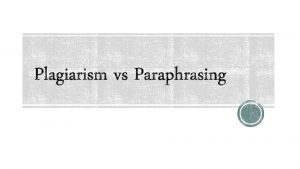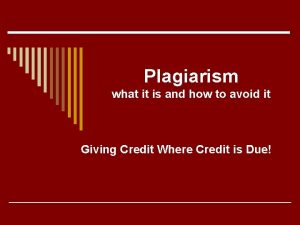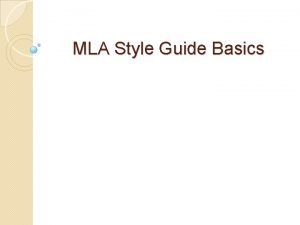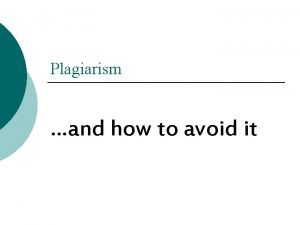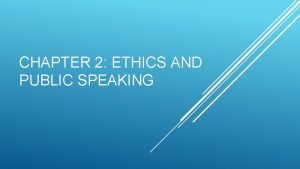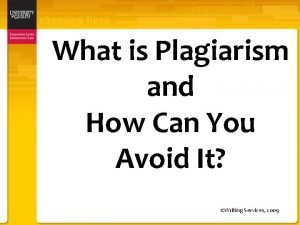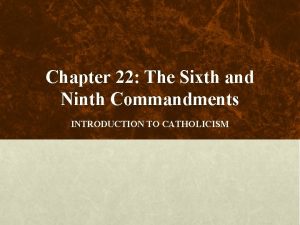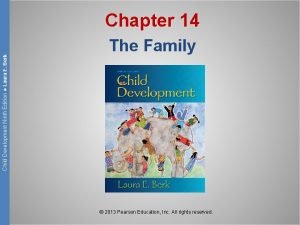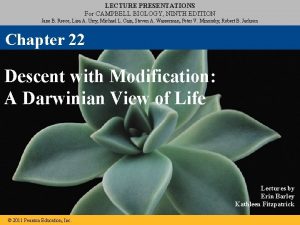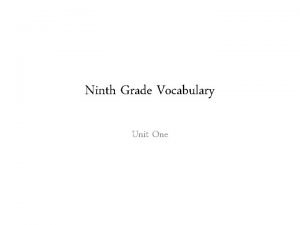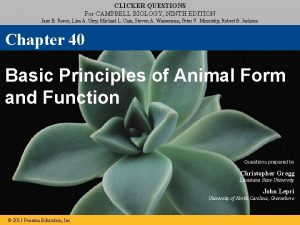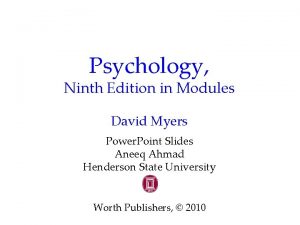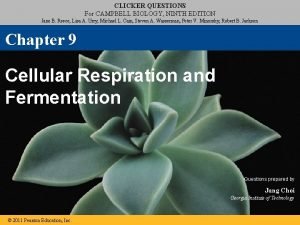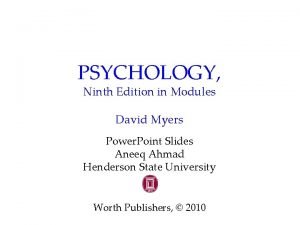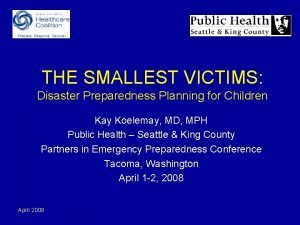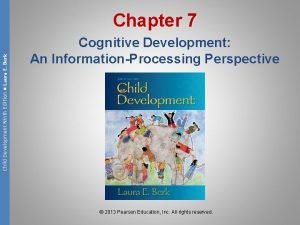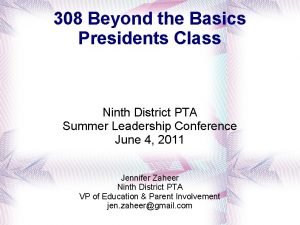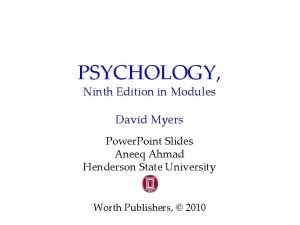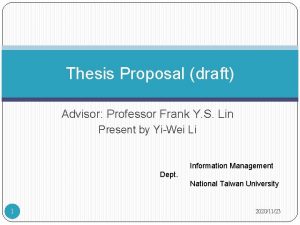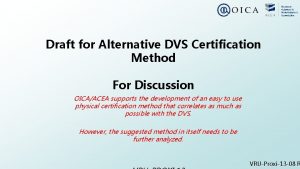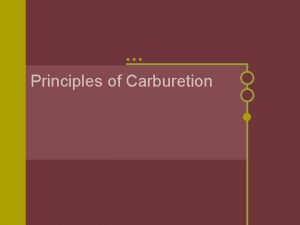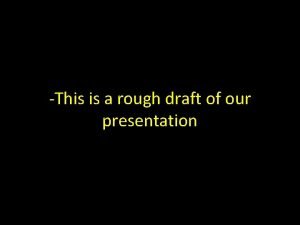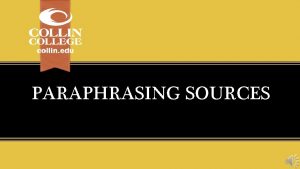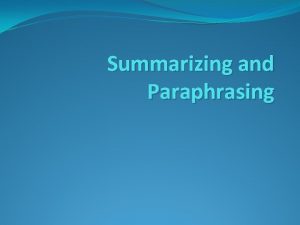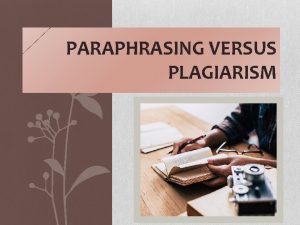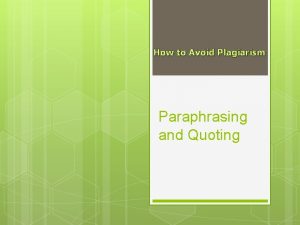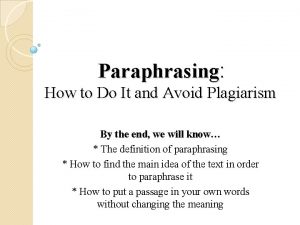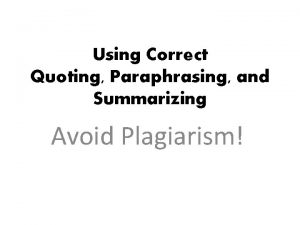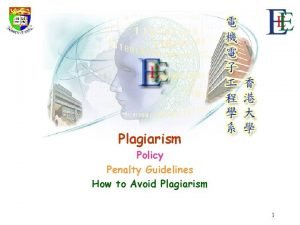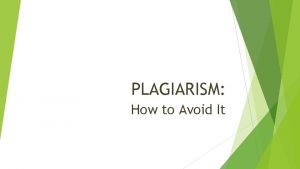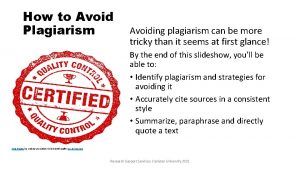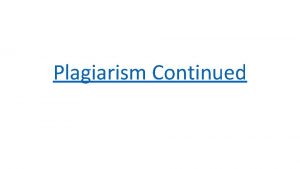Ninth Draft 2117 Tutorial on Paraphrasing Avoid plagiarism




































- Slides: 36

Ninth Draft 2/1/17 Tutorial on Paraphrasing Avoid plagiarism while strengthening your learning skills Part of the Academic Success Series A. Kent Van Cleave, Jr. , Ph. D. Kent. vancleave@aiuonline. edu

Executive Summary How to write a similarity free paper: • Learn the concepts well. • Do not copy sentences and then try to substitute words to reduce similarity – it never works (demonstrated below). • Read and outline your sources – with coding of sources for citation • Write from the outline, not the sources. • Cite and reference – but NEVER sources you did not access • Use quote marks for quotations, or indented paragraph. • Use Turnitin on the Originality Verification link.

Paraphrasing – What and Why Paraphrasing means taking the ideas of an author and putting them in your own words, followed by an appropriate citation. We cite and reference for several reasons. – First, we are giving credit to the author. – Second, we are giving the reader an opportunity to critically evaluate our statements by providing the authoritative source we are using, so the reader can go to that source herself.

Paraphrasing – What and Why We do this for several reasons. . . – Third, we demonstrate that we really understand the concepts we are presenting. If I cannot say something in my own words, I do not understand the concepts. If I do not understand the concepts, I have not mastered them. The value of an education comes not from the diploma, but from mastering the assigned concepts – in the process, mastering how to think effectively. The diploma will open doors for you, but only a good education will keep them open!

Paraphrasing – What and Why We do this for several reasons. . . – Fourth, we are following a tradition from the ancient Greeks—we are lending credibility to our arguments with the arguments of someone who has been judged by consensus in the scholarly community to know what s/he is talking about. We never cite or reference a source we did not access.

Paraphrasing – What and Why We paraphrase for several reasons. . . The instructor is supposed to evaluate whether the student “got” the concepts over which the assignment is designed to assess. This cannot be done if the words are not the student’s, whether they are quoted or just poorly paraphrased.

Paraphrasing – What and Why Many students have stated to me that they did not plagiarize, because they cited and referenced. Unfortunately, simply citing and referencing does not satisfy originality requirements. In order to satisfy originality requirements, one must cite and reference, but one must also paraphrase the sources so that one has written about the concepts in one’s own words.

Paraphrasing – What and Why Many students… They tell me that they changed several words in each sentence, and the similarity index from Turnitin is still too high! Some have told me that they simply cannot fix this problem… …but the problem is easily fixed if one shifts one’s focus. One must paraphrase at the concept level, not the sentence level.

Paraphrasing – What and Why They tell me that they changed several words in each sentence… It takes more time to do this than it does to do it the right way: • Create an outline from your sources. • Write your text using the outline as a guide • Cite and reference your sources.

Paraphrasing – What and Why An inability to paraphrase often indicates that the writer does not fully understand the concepts. Often, the concepts are not understood because the writer did not use an effective study method. SQ 3 R study method is a simple, easy to learn, easy to use approach that can help you master the concepts. You can find it in my Academic Success Series files.

Turnitin is a very useful tool for detecting plagiarism – or failure to paraphrase one’s sources. Instructors use it to preserve academic integrity. Students can use it to ensure that they have properly paraphrased. To use Turnitin on your own paper, click on the Originality Verification link in the virtual classroom (AIU), or Submit a Paper in the Center for Writing Excellence (Phoenix).

Turnitin To use Originality Verification, click on the link on almost any page of your course (AIU).

Turnitin Then click on the Add File link, and follow the prompts Above and to the left of the Add File link, is an orange line of text that reads, What is an Originality Report and How do you Read one? This will tell you a lot that you need to know about your report.

Turnitin Later, click on the similarity score where you turned in the assignment to see the report that tells you what is similar and what the sources are. Similarity should be less than 20%* once quotes and references are excluded from checking. *(20% is not an absolute guideline, only a general rule of thumb for undergraduate work. At the doctoral level, the standard is more like 10%. )

Turnitin If there is a source that is “in the way”, you can exclude that source from originality checking by clicking on the grey X, while in show highest matches together mode. Instructors do this to exclude entire papers when students resubmit their work.

Turnitin Like all tools, Turnitin has its dangers. It can be used, but it also can be abused. Instructors can fixate on numbers… …instead of paying attention to the real issue.

Turnitin Like all tools, Turnitin has its dangers…. Students can fixate on fixing sentences… …instead of using Turnitin to learn how to properly paraphrase. This changes the student’s learning model from learning concepts to learning how to reduce the similarity index. This pattern has become quite common, and it threatens the student’s learning success!

Turnitin The most common pattern of abuse of Turnitin is sentence paraphrasing, which is word substitution within existing sentences (Gordon, Simmons & Wynn, 2004). Students get back the similarity report, then substitute synonyms for key words in sentences flagged by Turnitin. In the process, their focus shifts off of the concepts and onto the similarity report.

Turnitin …Their focus shifts off of the concepts and onto the similarity report… In reducing similarity by this means, the students exert a level of effort that is comparable to the effort needed to learn the concepts… …and they do not master the concepts! They are working harder, not smarter… The synonyms subtly change the meaning of what they are writing. Often, it makes their sentences sound odd or silly.

Turnitin There is a paradox in sentence paraphrasing… At the sentence level, there are very few options for recombining ideas… …so similarity to source is highly likely regardless of the amount of effort one puts into the task. At the concept level, there are many more recombination options. A rough estimate is that recombination possibilities are a function of the square of the number of words one is paraphrasing.

Turnitin A more effective approach to this issue is to • learn the concepts first, • then create an outline of the concepts, • then write from the outline. This puts the focus on concept mastery, which is what the assignments are designed to assess! Example follows. . .

Turnitin I copied a passage from Boeree (2006), and pasted it into a Word document. Then I pasted again, but substituted some synonyms for a couple of key words in each sentence. Finally, I identified key points in the Boeree passage, then created an outline from the source, and wrote from the outline. All three of these passages were compiled in a Word document, which was submitted to Turnitin. The passages follow, with their Turnitin segments.

The passage “He is most famous for his work in refining and expanding Freud's theory of stages. Development, he says, functions by the epigenetic principle. This principle says that we develop through a predetermined unfolding of our personalities in eight stages. Our progress through each stage is in part determined by our success, or lack of success, in all the previous stages. A little like the unfolding of a rose bud, each petal opens up at a certain time, in a certain order, which nature, through its genetics, has determined. If we interfere in the natural order of development by pulling a petal forward prematurely or out of order, we ruin the development of the entire flower. Each stage involves certain developmental tasks that are psychosocial in nature. Although he follows Freudian tradition by calling them crises, they are more drawn out and less specific than that term implies. The child in grammar school, for example, has to learn to be industrious during that period of his or her life, and that industriousness is learned through the complex social interactions of school and family. The various tasks are referred to by two terms. The infant's task, for example, is called "trust-mistrust. " At first, it might seem obvious that the infant must learn trust and not mistrust. But Erikson made it clear that there it is a balance we must learn: Certainly, we need to learn mostly trust; but we also need to learn a little mistrust, so as not to grow up to become gullible fools!”

T u r n i t i n R e p o r t 100% similarity in this passage Turnitin nailed the source!

Synonym Substitution In my sentence paraphrasing, the words in red were substituted. He is best known for his work in refining and enlarging Freud's theory of stages. Development, he asserts, works by the epigenetic principle. This principle believes we develop through a predetermined opening of our personalities in eight stages. Our movement through each stage is in part caused by our success, or lack of success, in all the previous stages. A little like the opening of a flower, each petal opens up at a certain time, in a predetermined order, which … genetics has determined. If we tamper with the natural order of development by opening a petal prematurely or out of order, we ruin the … entire flower (Boeree, 2006). Each stage involves particular developmental tasks that are psychosocial …. Although he respects Freudian tradition by naming them crises, they are more lengthy and less specific than that term suggests. The child in elementary school, for example, has to learn to be industrious during that time of … life, and that industriousness is learned in the complex social interactions in the child’s school and family (Boeree, 2006). The … tasks are referenced by two terms. The infant's crisis, for example, is … trust-mistrust. …It might be apparent that the infant must learn trust and not mistrust. But Erikson clearly said that … it is a balance we must learn: Clearly, we need to learn mostly trust; but we also must learn a little mistrust, so we do not grow up to be gullible fools (Boeree, 2006)!

T u r n i t i n R e p o r t Only the words I substituted are not flagged. This student used the same source I did!

Key Points In outlining, first I note the key points. Words in green are the key points I spotted. He is most famous for his work in refining and expanding Freud's theory of stages. Development, he says, functions by the epigenetic principle. This principle says that we develop through a predetermined unfolding of our personalities in eight stages. Our progress through each stage is in part determined by our success, or lack of success, in all the previous stages. A little like the unfolding of a rose bud, each petal opens up at a certain time, in a certain order, which nature, through its genetics, has determined. If we interfere in the natural order of development by pulling a petal forward prematurely or out of order, we ruin the development of the entire flower. Each stage involves certain developmental tasks that are psychosocial in nature. Although he follows Freudian tradition by calling them crises, they are more drawn out and less specific than that term implies. The child in grammar school, for example, has to learn to be industrious during that period of his or her life, and that industriousness is learned through the complex social interactions of school and family. The various tasks are referred to by two terms. The infant's task, for example, is called "trust-mistrust. " At first, it might seem obvious that the infant must learn trust and not mistrust. But Erikson made it clear that there it is a balance we must learn: Certainly, we need to learn mostly trust; but we also need to learn a little mistrust, so as not to grow up to become gullible fools!

Outline I created an outline from the source. • Erikson developed Freud’s stage theory • Main principle is the epigenetic principle – develop through predetermined stages – one stage must be completed before the next stage will proceed normally • Each stage has a crisis – a developmental task the person must accomplish – Two terms (trust vs. mistrust) – Must balance between them • This crisis takes place over a relatively long period of time • Boeree example…

Paraphrase from Outline Then I wrote from the outline. Erikson, trained in psychoanalysis by Anna Freud (note: this is drawn from elsewhere in the Boeree text), used Freud’s stage theory as a starting point for his own, expanding and elaborating on Freud’s original theory. The central assumption of Erikson’s theory of psychosocial development (as opposed to Freud’s psychosexual theory) he called the epigenetic principle (Boeree, 2006). The epigenetic principle suggests that there are eight stages, through which each individual must progress in a predetermined order, and at fairly predetermined times. Each stage has a developmental task which must be accomplished, before moving on to the next stage. If that crisis, as Erikson called these tasks, is successfully resolved, all is well. But if the task is not successfully resolved, then this will impact negatively the person’s development through subsequent stages. For example, in the trust versus mistrust stage of infancy, if the infant is too trusting people will take advantage of him/her. However, if the infant is too mistrusting, s/he may never be able to form close attachments to others (Boeree, 2006).

The outline Text written from the outline The Turnitin Report Similarity match. Almost impossible to get 0%

Quoting If I am going to quote a source, I put the quoted text inside quote marks: “Each stage involves certain developmental tasks that are psychosocial in nature (Boeree, 2006). ” Or, if I am going to quote a lot of text, I should indent it as below: Each stage involves certain developmental tasks that are psychosocial in nature. Although he follows Freudian tradition by calling them crises, they are more drawn out and less specific than that term implies. The child in grammar school, for example, has to learn to be industrious during that period of his or her life, and that industriousness is learned through the complex social interactions of school and family (Boeree, 2006, para 27). Then return to the original left margin after citing the quote, with page number if available, else paragraph number.

Quoting Rarely is it ever appropriate to quote more than ten percent of the content of your paper. Whenever I receive a paper that is heavy on the quoted material my first thought is that the student does not truly understand the concepts being discussed.

Quoting When you quote, the Turnitin report will show similarity, but there is a link at the top of the report that allows you to Exclude Quoted. You should also exclude the references! If you do exclude a quote match, note what the percentage match is before and after excluding quoted, so you know how much quoting you did.

Further Study A very good online tutorial on these issues can be found at http: //www. wisc. edu/writing/Handbook/QP A_plagiarism. html

References Boeree, C. G. (2006). Erikson. Retrieved 11/24/2007 from http: //webspace. ship. edu/cgboer/erikson. html. Gordon, C. H. , Simmons, P. , & Wynn, G. (2004). Plagiarism – What it is and how to avoid it. University of Pennsylvania Library. Retrieved 11/26/2007 from http: //gethelp. library. upenn. edu/guides/engineeri ng/ee/plagiarize. html.

Academic Success Series • • • SQ 3 R. ppt A Academy. ppt Tutorial on Paraphrasing. ppt How to Use a Similarity Report More to come… Available from kent. vancleave@aiuonline. edu
 Heel and toe arrangement in carding
Heel and toe arrangement in carding Examples of paraphrasing
Examples of paraphrasing Difference between plagiarism and paraphrasing
Difference between plagiarism and paraphrasing Rephrasing someone else’s ideas without citation.
Rephrasing someone else’s ideas without citation. What is paraphrasing plagiarism
What is paraphrasing plagiarism Needed to avoid plagiarism
Needed to avoid plagiarism What is plagiarism and how to avoid it
What is plagiarism and how to avoid it Ethical speechmaking
Ethical speechmaking Intentional plagiarism
Intentional plagiarism How will you avoid plagiarism
How will you avoid plagiarism The sixth and ninth commandments
The sixth and ninth commandments Child development ninth edition
Child development ninth edition What is ramadan?
What is ramadan? Biology ninth edition
Biology ninth edition Who has introduced french classical menu
Who has introduced french classical menu Phos greek root words
Phos greek root words Fundamentals of abnormal psychology ninth edition
Fundamentals of abnormal psychology ninth edition William blount 9th grade academy
William blount 9th grade academy Campbell ninth edition
Campbell ninth edition Psychology ninth edition in modules
Psychology ninth edition in modules Biology ninth edition
Biology ninth edition Human anatomy & physiology edition 9
Human anatomy & physiology edition 9 Mankiw macroeconomics 9th edition
Mankiw macroeconomics 9th edition Psychology ninth edition in modules
Psychology ninth edition in modules Lower ninth ward
Lower ninth ward The six commandments of the catholic church
The six commandments of the catholic church Child development ninth edition
Child development ninth edition Psychology ninth edition david g myers
Psychology ninth edition david g myers Psychology ninth edition david g myers
Psychology ninth edition david g myers Ninth district pta
Ninth district pta Social psychology ninth edition
Social psychology ninth edition Thesis proposal
Thesis proposal Content of portfolio
Content of portfolio Dvs certification
Dvs certification Principle of carburetor
Principle of carburetor Draft
Draft Sports rough draft
Sports rough draft


